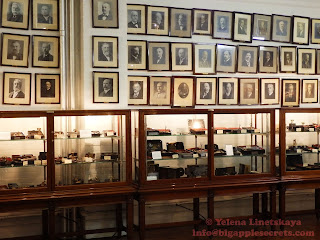 There are different clock in New York - some of them are plain old-fashion street clock and some of them are really confusing. I already wrote about the clock installed last fall near the southern entrance to Central Park. A 16-foot-tall clock has a face rotating counter-clockwise and its hands moving at correct time.
There are different clock in New York - some of them are plain old-fashion street clock and some of them are really confusing. I already wrote about the clock installed last fall near the southern entrance to Central Park. A 16-foot-tall clock has a face rotating counter-clockwise and its hands moving at correct time. Another unusual and maybe really confusing clock is located along the south end of Union Square. A lot of people do not even know that this installation is a clock. Some think that these fifteen spinning numbers represent national debt, other think that it is the age of our planet in seconds....
 This numbers are a part of the installation on the face of One Union Square South was designed in 1999 by American artists Kristen Jones and Andrew Ginzel, and it's called the “Metronome”.
This numbers are a part of the installation on the face of One Union Square South was designed in 1999 by American artists Kristen Jones and Andrew Ginzel, and it's called the “Metronome”. Here is the description of this installation from the site of the artists:
"The elements that compose Metronome refer to and are very much a part of the place where the work exists: Union Square in the City of New York. The central element is a brick wall built in concentric circles(....). Gold leaf accentuates the center of the work. At noon and midnight the hole erupts with a huge plume of steam that is accompanied by an explosion of sound composed to mark the exact instant and its passage, like a noonday whistle or a public clock that marks the time. Below on the wall is a massive piece of bedrock, displaying the millennia of geological history. A long thin bronze cone is poised at a diagonal on the rippling brick façade: a time indicator that suggests perspective.
On the right metallic façade is a sphere, half black and half gold, which turns daily in synchrony with the phases of the moon. When the moon reaches fullness, the entire golden face of the orb is revealed."
 And on the left from the brick wall is the most confusing clock in New York. Let's take a look at the picture that I made. The clock reads 134552673071410 , it means that 13 hours, 45 minutes, 52 seconds have passed since midnight. Therefore, it is 1:45 PM. There are also 10 hours, 14 minutes, 7 seconds until the next midnight. And what about three numbers in between? Here is the answer: " The center three digits are a frenzy of intangible fractions of seconds, which reveal the pace of life in the city. Like an hourglass that contains a specific measure of sand, the digital time piece counts up on the left and down on the right, measuring both the sum and the balance of the day."
And on the left from the brick wall is the most confusing clock in New York. Let's take a look at the picture that I made. The clock reads 134552673071410 , it means that 13 hours, 45 minutes, 52 seconds have passed since midnight. Therefore, it is 1:45 PM. There are also 10 hours, 14 minutes, 7 seconds until the next midnight. And what about three numbers in between? Here is the answer: " The center three digits are a frenzy of intangible fractions of seconds, which reveal the pace of life in the city. Like an hourglass that contains a specific measure of sand, the digital time piece counts up on the left and down on the right, measuring both the sum and the balance of the day." Kristin Jones and Andrew Ginzel have worked collaboratively since 1985 on many commissioned private and public projects, as well as museum and gallery exhibitions.
Kristin Jones and Andrew Ginzel have worked collaboratively since 1985 on many commissioned private and public projects, as well as museum and gallery exhibitions. At the same year the artists did another installation in New York: three hundred mosaic eyes created in stone and glass were inset on the white tiles in the subway stations station in lower Manhattan. This installation was named Oculus.
 One of the stations were these eyes were installed, the former World Trade Center Station, was flooded and closed to the public following the September 11, 2001 attack. The site was damaged but not destroyed, and it reopened eight months later with the work mostly intact. You can see mosaic on Park Place station (2,3 trains) and Chamber Street (A,C trains).
One of the stations were these eyes were installed, the former World Trade Center Station, was flooded and closed to the public following the September 11, 2001 attack. The site was damaged but not destroyed, and it reopened eight months later with the work mostly intact. You can see mosaic on Park Place station (2,3 trains) and Chamber Street (A,C trains).















































